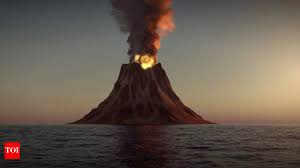Have you ever wondered how volcanoes can exist under the ocean? These underwater volcanoes, also called submarine volcanoes, are powerful natural features that shape our planet in many ways. Let’s explore how they form, erupt, and affect the environment.
🌊 What Are Submarine Volcanoes?
Submarine volcanoes are volcanoes that form under the sea. Even though we don’t see them, they are very common — about 70% of all volcanic activity on Earth happens underwater!
They form when magma (hot melted rock) rises from deep inside the Earth through cracks in the ocean floor. When it cools down, it builds mountains and ridges on the seafloor. Over time, some of these volcanoes grow tall enough to become islands, like Hawaii once did.
🔥 How Do Underwater Volcanoes Form?
Most underwater volcanoes form in three main ways:
-
At mid-ocean ridges:
Here, tectonic plates move apart and magma rises to fill the gap. As it cools, it forms new crust and builds underwater mountains. -
At subduction zones:
When one tectonic plate slides under another, it melts and creates magma. This magma can form volcanoes and island chains. -
At hotspots:
Hotspots are places where very hot material rises from deep inside the Earth. As the tectonic plate moves, a chain of volcanoes forms — like the Hawaiian Islands, which started underwater.
💥 What Happens During an Underwater Eruption?
When magma breaks through the seafloor, it meets seawater — and this decides how the eruption behaves.
-
In deep water, the pressure is very high, so eruptions are quiet and slow. The lava cools quickly, forming smooth, rounded shapes called pillow lava.
-
In shallow water, pressure is lower. Magma can cause violent steam explosions, throwing ash and rock into the water and sometimes into the air.
🔬 How Scientists Find Underwater Eruptions
Since these volcano are deep and hard to see, scientists use technology to study them.
They track them using:
-
Seismometers (to detect vibrations)
-
Hydrophones (to listen for underwater sounds)
-
Satellites (to spot changes in water temperature or color)
Sometimes, floating pumice stones washing up on beaches are clues that a volcano has erupted underwater.
🌎 How Do Underwater Volcano Affect the Environment?
Underwater eruptions can have big effects:
-
Tsunamis: Powerful eruptions can push huge amounts of water, creating tsunamis that travel across oceans.
-
Ash and gases: Some eruptions send ash and gases into the air, which can affect air quality and even change the weather.
-
Marine life: Sudden temperature changes and chemicals from eruptions can harm fish and coral reefs. Some areas take years to recover.
A famous example is the 2022 Tonga eruption, which caused a massive tsunami and sent ash high into the atmosphere.
🔭 Why It’s Hard to Study Them
Studying submarine volcano is not easy. They are often thousands of meters deep, where it’s dark, cold, and under huge pressure. Scientists use robots and sonar to map and study them, but it’s expensive and risky work. Many underwater eruptions are discovered only years later.
🧭 Conclusion
Underwater volcano remind us that our planet is always changing — even in places we can’t see. These hidden giants create new land, shape the seafloor, and influence life in the ocean. Though difficult to study, each discovery about submarine volcanoes helps scientists understand Earth’s powerful forces better. The next time you look at the calm ocean, remember — beneath those waves, our planet is still alive and growing.







Leave A Comment